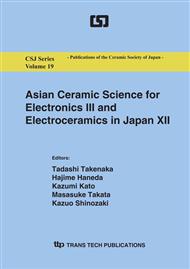p.490
p.494
p.498
p.502
p.506
p.510
p.514
p.521
p.525
Particle Structure Analysis of Highly-Dispersed Barium Titanate Nanoparticles Obtained from Barium Titanyl Oxalate Nanoparticles and their Dielectric Properties
Abstract:
Barium titanate (BaTiO3) nanoparticles were prepared by two-step thermal decomposition method of barium titanyl oxalate nanoparticles with a size of 30 nm. The BaTiO3 particle sizes were changed from 12.3 to 142 nm by control of temperature at 2nd step. The X-ray diffraction (XRD) measurement revealed that a clear splitting of 002 and 200 planes was observed over 40 nm, and the c/a ratio of 1.0089 was obtained for the BaTiO3 nanoparticles with a size of 62.3 nm. This high c/a ratio in the BaTiO3 nanoparticles suggested that its mesoscopic particle structure was composed of very thin surface cubic layer below 5 nm. Thus, synchrotron XRD data were analyzed using a “two layers” model and a “three layers” model. The Rietveld analysis using the three layers model resulted in the particle structure with a cubic layer thickness of 2.5 nm and structure gradient layer thickness of 7.5 nm. Finally, the dielectric constant of these BaTiO3 nanoparticles with thin surface cubic layer was measured at room temperature, and the maximum dielectric constant over 30,000 was obtained at the nanoparticles with a size of 83.6 nm.
Info:
Periodical:
Pages:
506-509
Citation:
Online since:
December 2009
Authors:
Price:
Сopyright:
© 2010 Trans Tech Publications Ltd. All Rights Reserved
Share:
Citation:


